


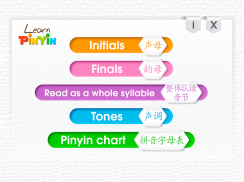
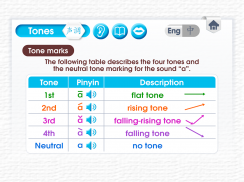
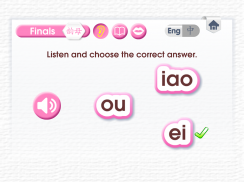
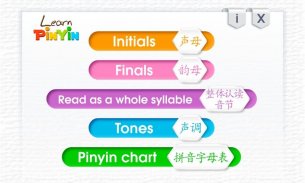
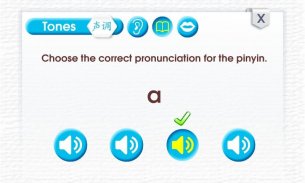
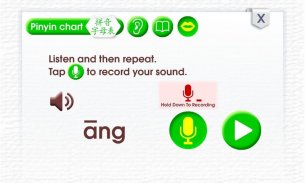
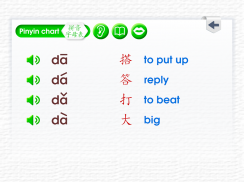

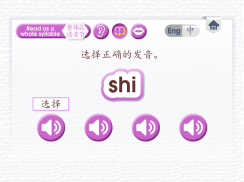
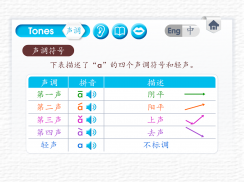
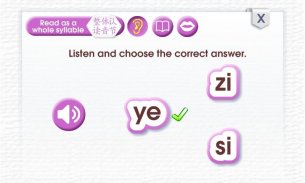
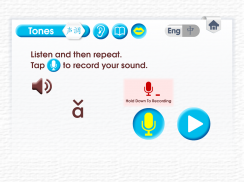
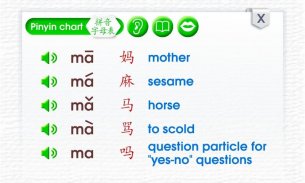
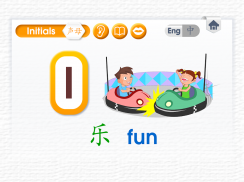
Learn Pinyin

Description de Learn Pinyin
Pinyin, short for Hanyu Pinyin, means "phonetic notation" or "phonetic symbols". Pin means "spelling" and Yin means "sound(s)". Pinyin is a system of romanization (phonemic notation and transcription to Roman script) for Standard Mandarin. There are 21 initials/consonants and 35 finals/vowels in Mandarin.
Pronunciation of Mandarin comes with two aspects: syllables and tones. Each can be practised separately, but when it comes to speaking, learners must pronounce words with proper tones.
A Mandarin syllable consists of three components: an initial, a final and a tone. The initial and final sounds make a total of 56 basic sounds. Combinations of initials and finals, and the special cases result in more than 400 mono-syllabic sounds. By applying the four tones to the sounds, Standard Mandarin makes a total of around 1,600 unique syllables.
Initials and Finals
The pronunciation of Chinese Pinyin is generally given in terms of initials and finals, which represent the segmental phonemic portion of the language, rather than letter by letter. Initials are initial consonants, while finals are all possible combinations of semivowels coming before the vowel, the nucleus vowel, and final vowel or consonant.
A semivowel is a sound that is phonetically similar to a vowel sound but functions as the syllable boundary rather than as the nucleus of a syllable.
Tones
Mandarin Chinese is a tonal language. Each Chinese character/syllable has a tone. The same syllable can have 5 possible ways to pronounce by varying the tone (pitch). There are four main tones and a neutral tone (轻声qīngshēng) in Mandarin. One syllable, pronounced in different tones will usually mean different things. This fact makes the tone training a fundamentally important part of Mandarin learners. So, even if you can pronounce the pinyin of a Chinese character correctly but if you do not master tones, Chinese speakers will not understand you.
If you have suggestions on how we can improve this application, please send us your feedback. We value your input; it can make a world of difference to the learning experience of other learners who use this app.
E-mail us at: admin@e-unik.com.my
Pinyin, pour Hanyu Pinyin, signifie "notation phonétique" ou "symboles phonétiques". Pin signifie "épellation" et Yin signifie "son (s)". Le pinyin est un système de romanisation (notation phonémique et transcription en caractères latins) en mandarin standard. Il y a 21 initiales / consonnes et 35 finales / voyelles en mandarin.
La prononciation du mandarin a deux aspects: les syllabes et les tons. Chacun peut être pratiqué séparément, mais lorsqu'il s'agit de parler, les apprenants doivent prononcer des mots avec les tonalités appropriées.
Une syllabe en mandarin est constituée de trois éléments: une initiale, une finale et une tonalité. Les sons initiaux et finaux produisent un total de 56 sons de base. Les combinaisons d'initiales et de finales, ainsi que les cas spéciaux, génèrent plus de 400 sons mono-syllabiques. En appliquant les quatre tons aux sons, Standard Mandarin crée un total d'environ 1 600 syllabes.
Initiales et finales
La prononciation du chinois en pinyin est généralement donnée en termes d'initiales et de finales, qui représentent la partie phonémique segmentaire de la langue, plutôt que lettre par lettre. Les initiales sont des consonnes initiales, tandis que les finales sont toutes les combinaisons possibles de demi-voyelles précédant la voyelle, la voyelle à noyau et la voyelle ou consonne finale.
Un semi-timel est un son qui est phonétiquement similaire à un son de voyelle mais qui fonctionne comme la limite d'une syllabe plutôt que comme le noyau d'une syllabe.
Tonalités
Le chinois mandarin est une langue tonale. Chaque caractère chinois / syllabe a une tonalité. La même syllabe peut avoir 5 manières possibles de se prononcer en faisant varier le ton (pitch). Il existe quatre tonalités principales et une tonalité neutre (轻声 qīngshēng) en mandarin. Une syllabe, prononcée dans des tons différents, signifie généralement différentes choses. Ce fait fait de la formation tonale une partie fondamentalement importante des apprenants en mandarin. Ainsi, même si vous pouvez prononcer correctement le pinyin d'un caractère chinois, mais si vous ne maîtrisez pas les sons, les locuteurs chinois ne vous comprendront pas.
Si vous avez des suggestions pour améliorer cette application, envoyez-nous vos commentaires. Nous apprécions votre contribution. l'expérience d'apprentissage d'autres apprenants qui utilisent cette application peut faire toute la différence.
Envoyez-nous un mail à: admin@e-unik.com.my

























